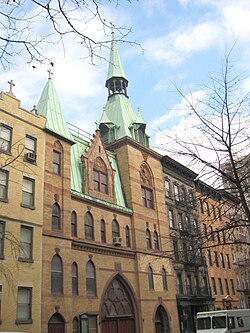St. Elizabeth of Hungary Church
| Church of St. Elizabeth of Hungary | |
|---|---|
 Photographed in 2009 | |
 | |
| General information | |
| Architectural style | Gothic Revival |
| Town or city | Manhattan, New York City |
| Country | United States |
| Completed | 1918[1] |
| Client | Roman Catholic Archdiocese of New York |
| Technical details | |
| Structural system | Masonry brick with terracotta trim |
| Design and construction | |
| Architect(s) | ? |
| Website | |
| St. Elizabeth of Hungary Church, Manhattan | |
The Church of St. Elizabeth of Hungary is a Roman Catholic parish church in the Roman Catholic Archdiocese of New York, located at 211 East 83rd Street, between Second and Third Avenues, on the Upper East Side of Manhattan, New York City.
In November 2014, the Archdiocese announced that the Church of St. Elizabeth of Hungary was one of 31 neighborhood parishes which would be merged into other parishes.[2] St. Elizabeth of Hungary and St. Stephen of Hungary were to be merged into the Church of St. Monica at 413 East 79th Street.[3]
The church was deconsecrated on June 30, 2017.[4] The church had earlier been considered for, but did not receive, landmark status from the New York City Landmarks Preservation Commission.[5]
History
St. Elizabeth's was founded by Slovakian immigrants on the Lower East Side, with the first Mass celebrated on April 26, 1891 in the basement of St. Bridget's Church on 8th Street and Avenue B.[6][7] The first church building was located 345 East 4th Street, which hosted its first Mass on August 7, 1892. A special feature of the New York Times in 1901, mentioned the church, listed as "the Hungarian church," among other Catholic structures in the Lower East Side of Manhattan, describing the group "for the most part...limit[ing] themselves to the functions of a parish church, in districts where social needs are otherwise supplied." Without comment on other facilities attached.[8]
As parishioners relocated, it became necessary to move the parish. The former Second Emmanuel Lutheran Church church on East 83rd Street, built in 1892, became the new home for St. Elizabeth's on June 7, 1917.[6] It underwent several expansions in the following decades.[6]
As the local Slovak population declined later in the 20th century, Cardinal Cooke redesignated it as a church for the deaf Catholics of New York on July 1, 1980.[6]
Building
The AIA Guide to NYC (Fifth Edition, 2010), neglects to mention an architect, describing the Gothic Revival church as "a class, spired neo-Gothic exterior, is the treat is within: ascent the stairs to view a just heavenly vaulted ceiling painted in the colors o of Ravenna's mosaics."[1]
References
- ^ a b White, Norval; Willensky, Elliot; Leadon, Fran (2010). AIA Guide to New York City. American Institute of Architects New York Chapter (Fifth ed.). Oxford: Oxford University Press. p. 478. ISBN 978-0-19-538386-7.
- ^ Otterman, Sharon. "Tears and Heartache for New York’s Catholics as Cardinal Shuts Churches" New York Times (November 2, 2014)
- ^ "List of Merging Churches and Those That Will Cease Regular Services" New York Times (November 2, 2014)
- ^ Dolan, Timothy Michael (June 30, 2017) "Decree on the Relegation of the Church of Saint Elizabeth of Hungary in the Parish of Saint Monica-Saint Elizabeth of Hungary-Saint Stephen of Hungary, New York" Office of the Cardinal, Archdiocese of New York
- ^ Zimmer, Amy (July 26, 2017) "A Dozen Church Properties Deconsecrated by Archdiocese for Potential Sale" Archived 2017-08-22 at the Wayback Machine DNAinfo
- ^ a b c d "Our History", StElizabethofHungaryNYC.org, retrieved February 7, 2011
- ^ Remigius Lafort, S.T.D., Censor, The Catholic Church in the United States of America: Undertaken to Celebrate the Golden Jubilee of His Holiness, Pope Pius X. Volume 3: The Province of Baltimore and the Province of New York, Section 1: Comprising the Archdiocese of New York and the Diocese of Brooklyn, Buffalo and Ogdensburg Together with some Supplementary Articles on Religious Communities of Women.. (New York City: The Catholic Editing Company, 1914), p.325.
- ^ "Centres of Civilization; On the Lower East Side of New York", New York Times, Jul 21, 1901. Excerpt: “Everybody who read it must have been struck by a remark of Mr. Hewitt's, made not very long ago, touching the tenement house district, which was considerably commented on in the press. The remark was that it was not only the part of humanity and charity for the more favored to assist the less favored, but that in this particular case, it was not less the part of prudence…..St. Nicholas in Second Street, St. Rose of Lima in Cannon Street, and St. Teresa in Henry Street. There is also a remarkable church, remarkable for the ...””


